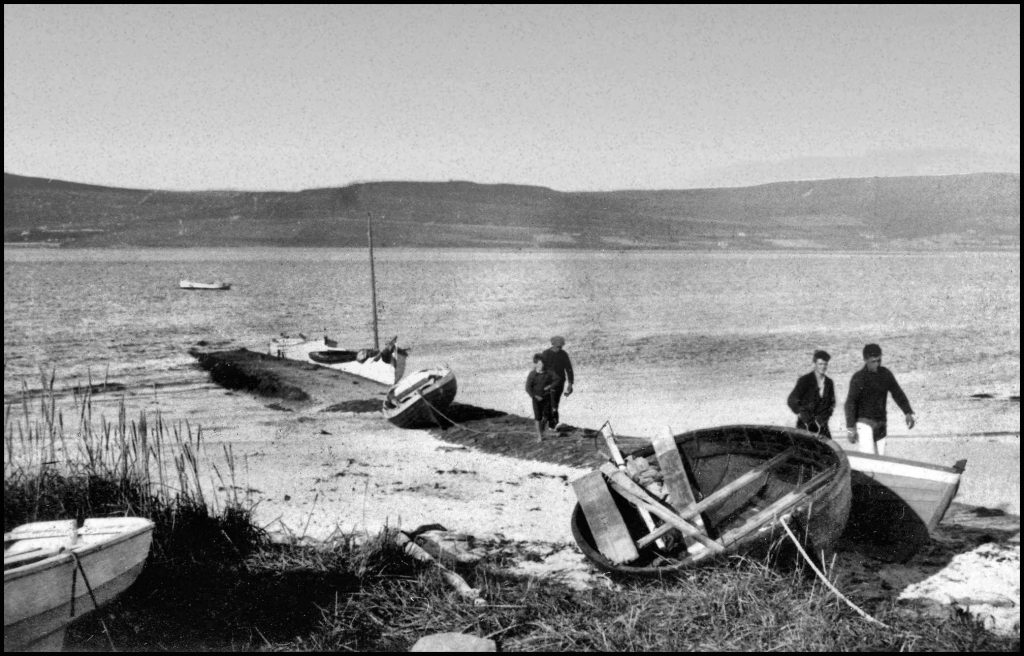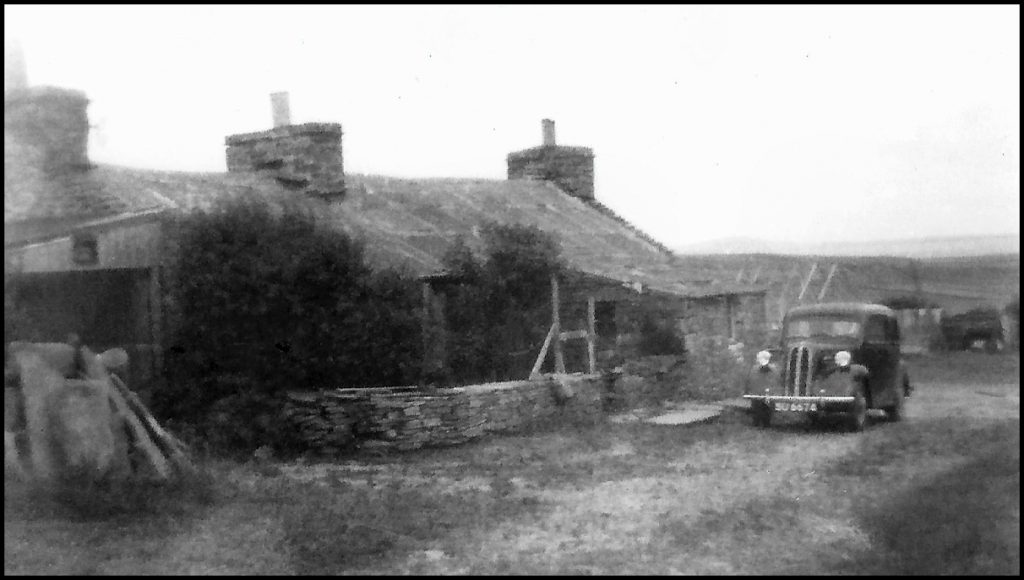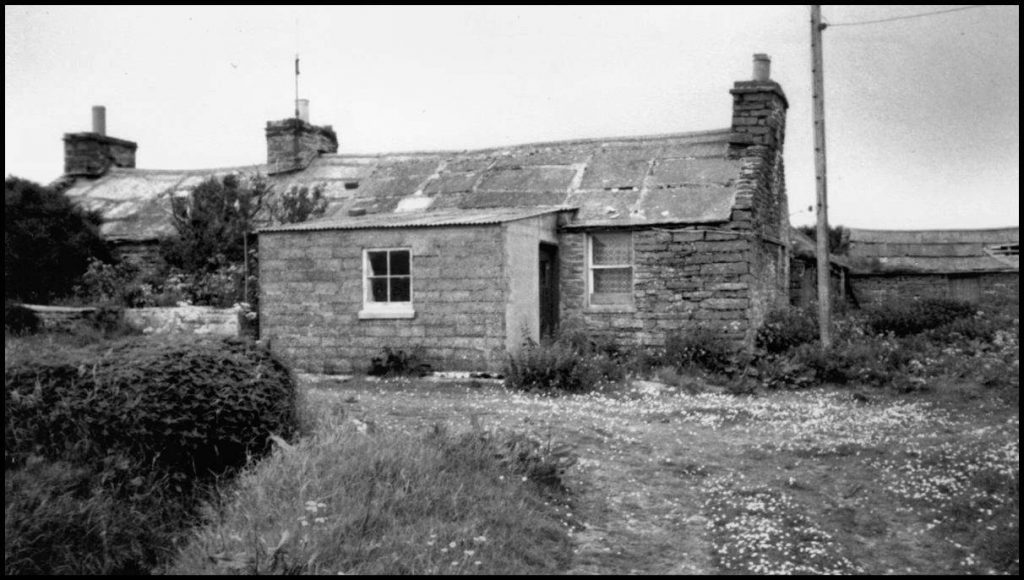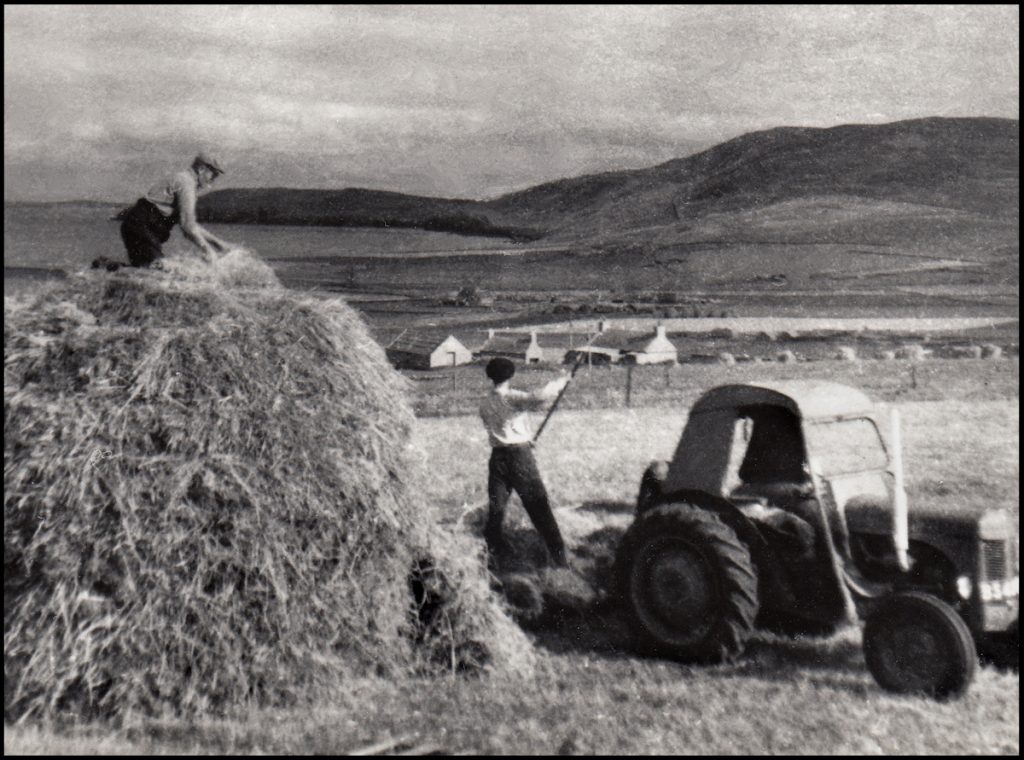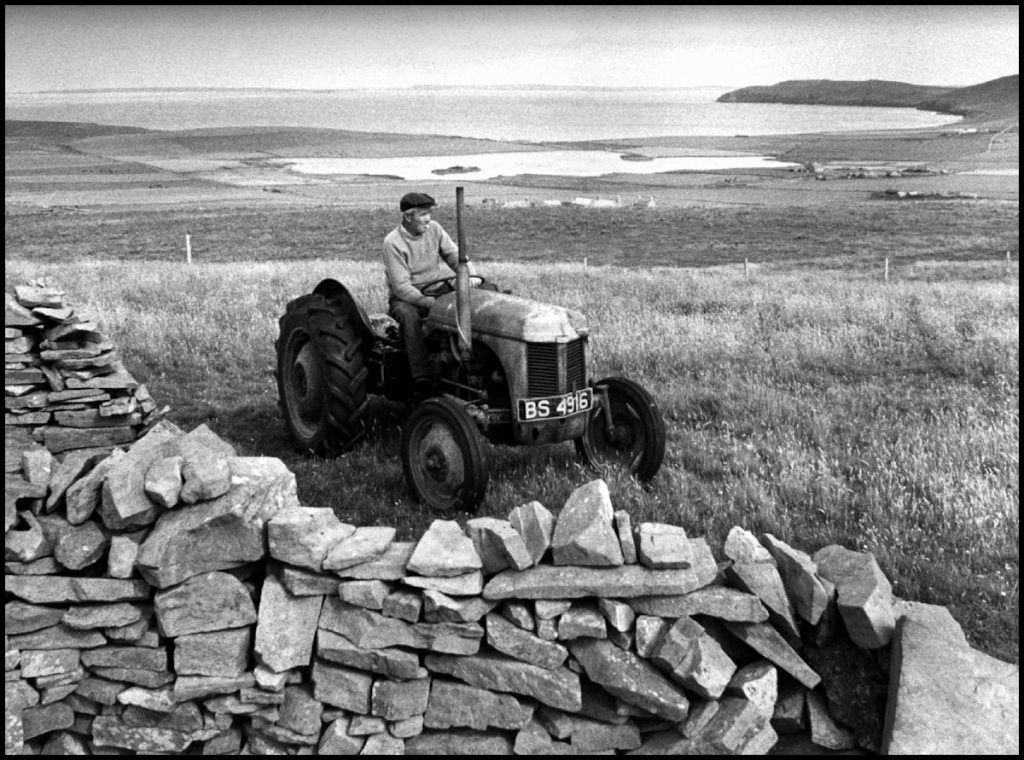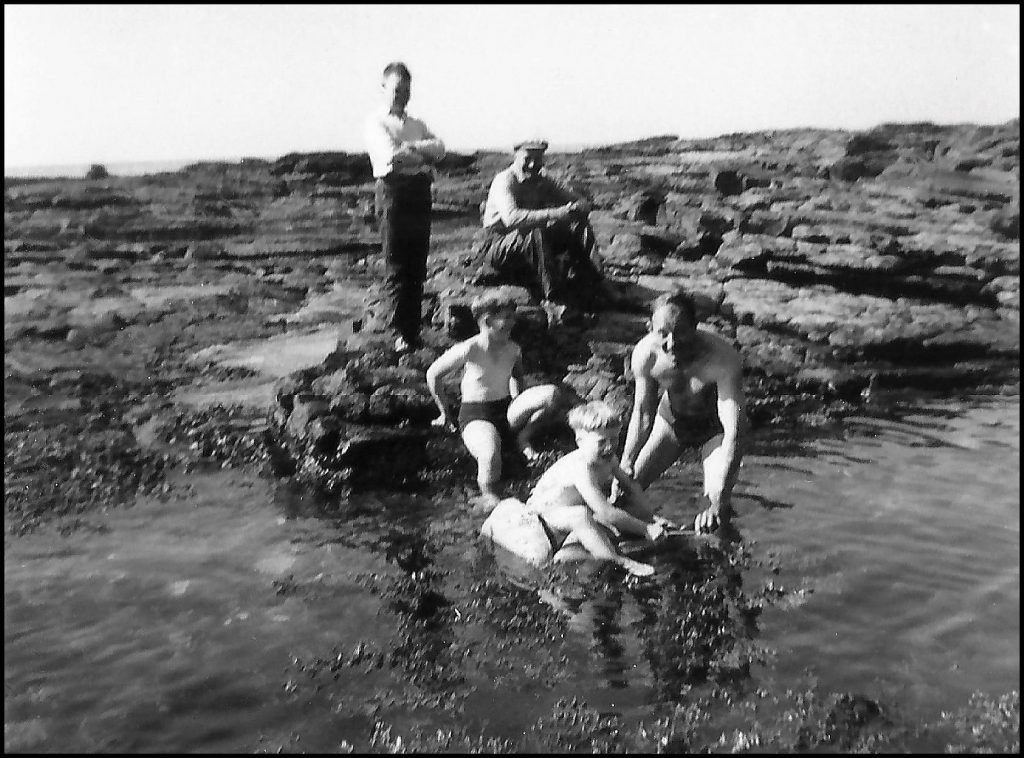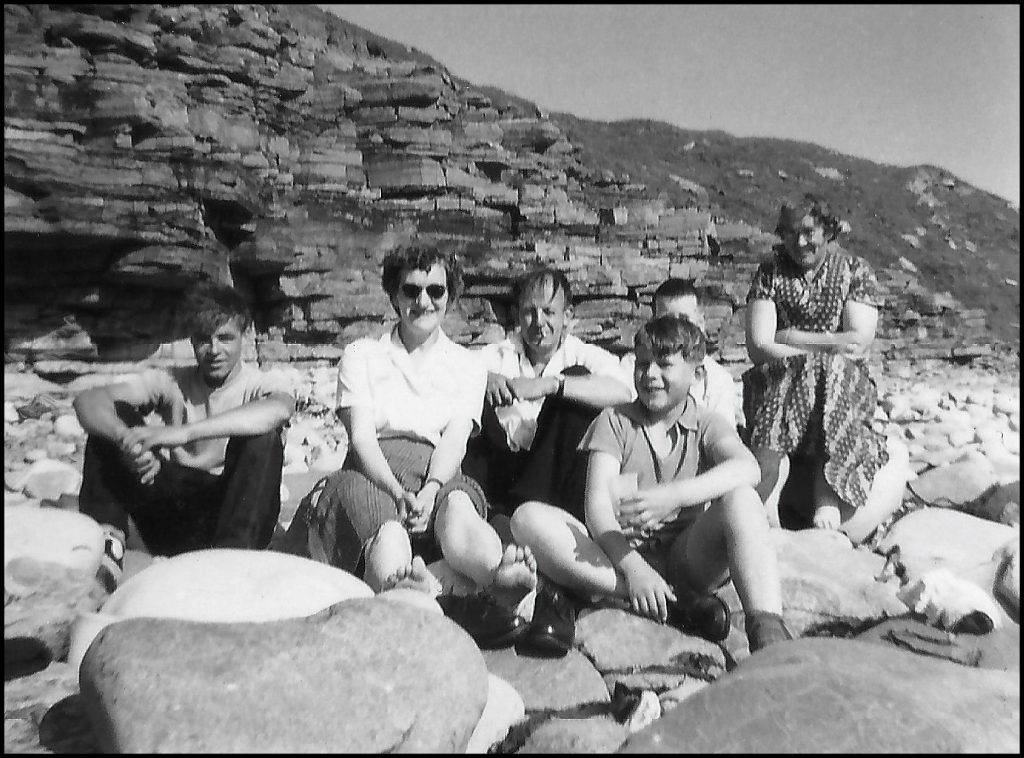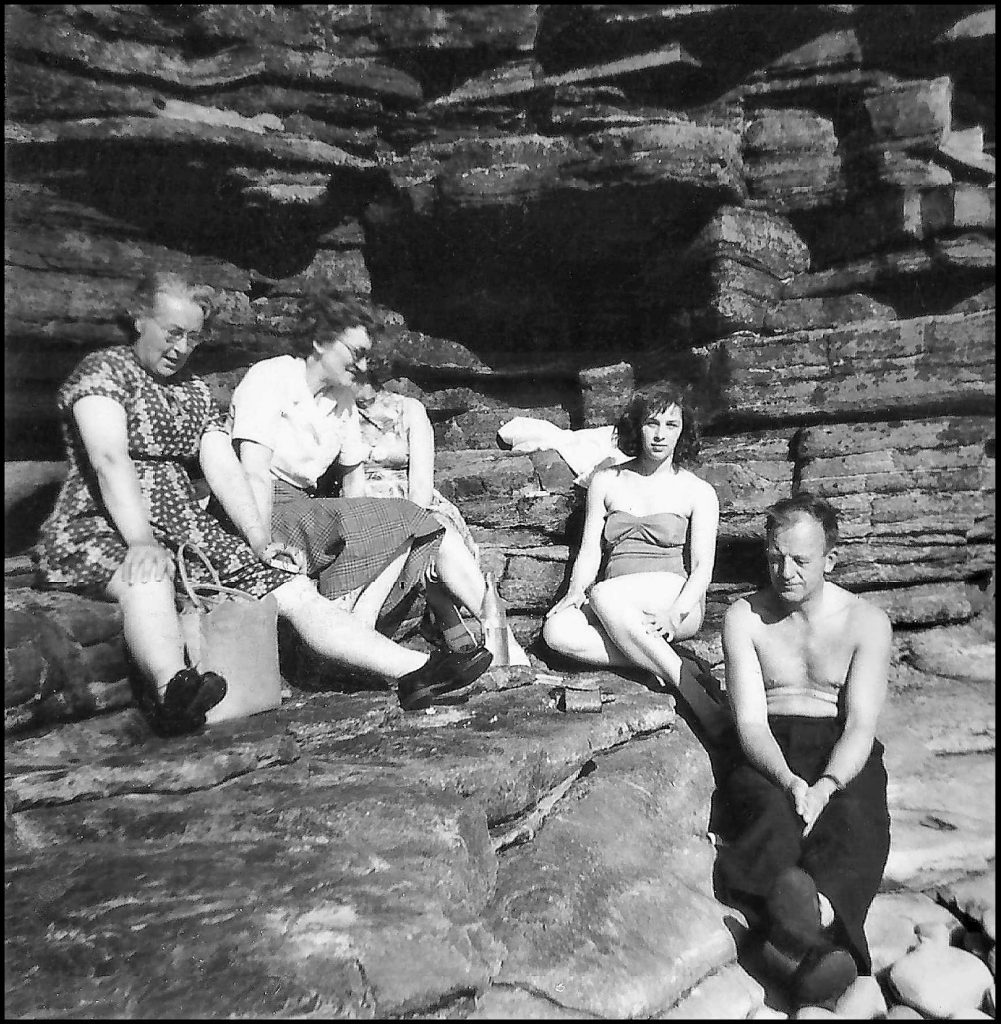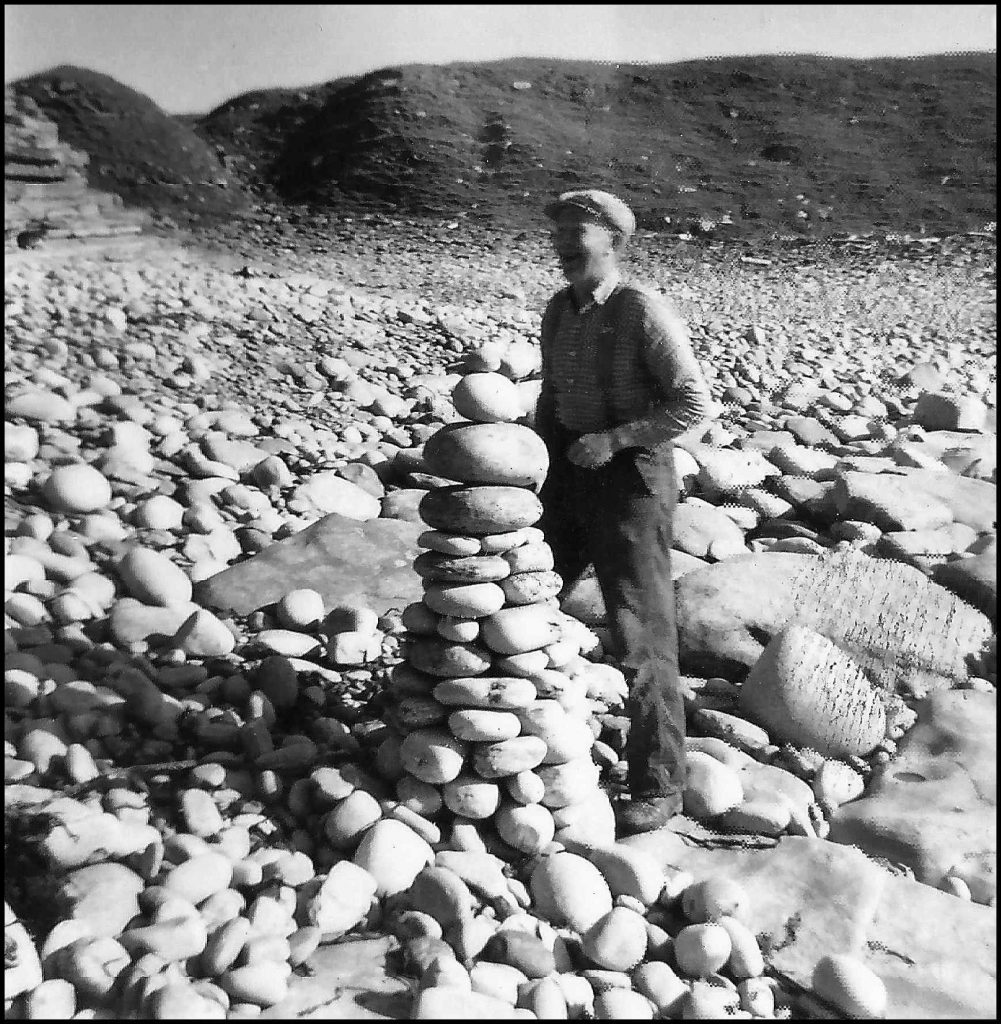Reminiscences of Hammerfield and Rousay
by
Ron Spence
In the fifties my family spent much of our long summer holidays in Wasbister, Rousay. My mother, Rhoda, had been widowed before my first birthday so her family consisted of my older sister, Elaine, me, and my younger brother, Jimmy. My first memory of Rousay was when I was about five years old so that might have been the summer of 1951/52. At that time the mail-boat ran from the pier in Evie to an old slipway near Hullion in Frotoft. The vessel was a clinker-built boat powered by an engine mid-ships and it seemed to be rather temperamental. At that time little protection was available for passengers but an old tarpaulin was produced in times of really bad weather. Some time later a cabin appeared, but I still preferred to stay outside. The ferryman was young Tom o’ Banks (Sinclair I learned later) who was Mum’s first cousin (one of the many). He sported a grizzly looking black beard and wore a heavy blue jersey and he was a merry fellow.
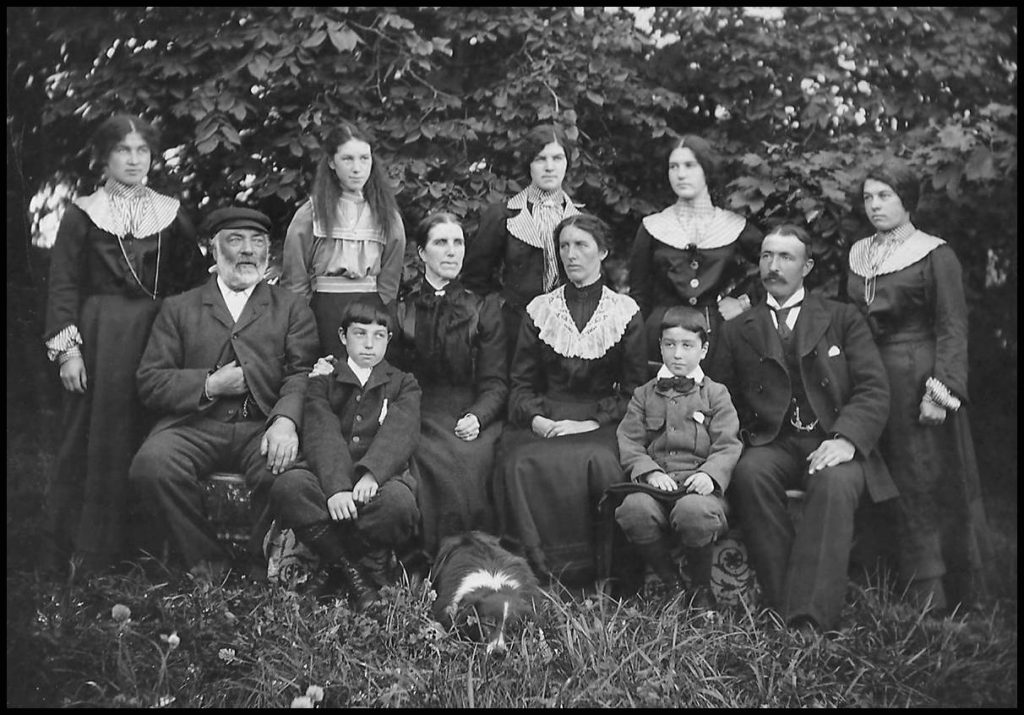
Back row (from left):- Ann, Janet, Lily, Mimie, and Mary.
Middle row:- Hugh and Mary (the parents), Isabella, and Fred.
Front row:- David and Robert.
Perhaps I should give a little background to my family’s connections with Rousay. My maternal grandmother, Jemima (Mimie) Inkster, was born at Greenfield in Harroldswick, Unst, as were all of her seventeen siblings. My great-grandfather, Hugh Inkster, was a Rousay man from Ervadale in Sourin. In 1861 he was working at Saviskaill as a ploughman and in 1865 he married Isabella Kirkness of Quoyostray. Soon thereafter the couple moved to Unst. Unfortunately in 1882 Isabella died, so in 1883 Hugh returned to Rousay to marry again, to Mary Kirkness of Grain, Isabella’s first cousin. Mary was my great-grandmother. Sometime between 1894 and 1901 my great-grandfather moved the whole family back to Rousay where, I understand, he took over the tenancy of Westness Farm. In 1905 my grandmother’s older sister, Mary, married Thomas Sinclair of Banks in Frotoft and their children were; Thomas, Anne (Cissie), Mary Isabel (Mabel) and Lily. Thomas ran the mail-boat, which was later taken over by his son, also Thomas, who married Bella Flaws of Wyre. Cissie married Bill Moar of Saviskaill and they moved to Leslie in Aberdeenshire. Mabel married Bill Flaws of Hammerfield and Lily married Dave Miller of Hestival in Evie. Lily was the schoolteacher for Wasbister and Dave worked as a radio operator for a whaler out of South Georgia. My grandmother, Jemima (Mimie), married James Groundwater of Kirkwall. He and his brother, John, owned J. F. Groundwater the baker and grocer.
My grandfather (Da, as we called him) drove us to Evie, a journey which seemed to take forever, and escorted us to the boathouse to await the crossing. Inside there were some men seated around a small table, or maybe it was a barrel, playing some mysterious game of cards. It involved lots of counting and shouting. I learned much later that it was cribbage. The game had to be completed so we waited patiently. Presently, Uncle Tom took us all down to the mail-boat moored at the jetty. It was a sunny day with a light wind but the sea in the Sound looked quite choppy. I was looking forward to the trip and it did turn out to be rather exciting; lots of bouncing around and spray so I don’t think Mum liked it much. I don’t know how long it took but it might have been forty minutes. The jetty on our arrival turned out to be a rather rudimentary affair with many loose stones, so some care was needed in disembarking. In fact the jetty was abandoned later to an alternative a couple of hundred metres to the east.
My First Memories
Uncle Bill (Flaws) met us and helped to unload the mailbags and then we piled into his car. It may have been the Old Fordie as Auntie Mabel called it later; I didn’t know about cars then. We set off along the single track road through the Westside past Banks and Westness. The car seemed to wheeze its way along and there were a great many gear changes. We eventually passed through the Quandale Dyke and turned left at Mansie Flaws’ house, a green painted wooden shack not far from Deithe. The track was rough and steep and took us down the hill to the rear of the farm. This road has long since been abandoned, however it can still be seen on Ordnance Survey maps. Hammerfield is located high on the braes and looks south and east towards Wasbister Loch and Saviskaill Bay. The road ‘ower the Leeon’ snakes up the hill towards Sourin and Faraclett Head is visible in the far distance. It is a beautiful view but at the time I didn’t really appreciate it.
Hammerfield
Auntie Mabel welcomed us at the door and ushered us through the lean-to dairy into the kitchen. It was a bit of a shock; a huge black range dominated the room, a Tilley lamp hung from the ceiling among a curtain of caithes (colefish). On the wall opposite the range was the box bed where Mabel and Bill slept. And it was dark, with only two small windows to lighten the room. I suppose that Hammerfield was like many other small Rousay farms; the kitchen with the box bed, ben to the peedie parlour (quite bright and airy though) with a fireplace and another box bed backing on to the kitchen’s, up a step to a corridor with a store room (possibly doubling as a bedroom) to the right and on to the bedroom where the old lady slept. I don’t recall ever having met her but my sister tells me that she was always dressed in a long black dress and occupied the creaking rocking chair in the corner by the range. I discovered later that she was Bill’s mother but she died the following year. But no toilet or bathroom! You had to outside, round the back to the privy.

No running water either; this had to be collected daily in bright galvanised buckets from the well in the field below the farm. I remember the water being crystal clear but Auntie Mabe occasionally had to skim debris, mostly bits of grass, from its surface. Waste from the privy was buried; it was NOT considered proper to throw it onto the midden. After the old lady’s death some improvements were made, but still no indoor plumbing. The box beds disappeared, giving an extra room, and running water was introduced using a black Alkathene pipe running from a spring on the hill above the farm to a tap next the byre door. The kye were much more important than the mere humans. At some time later the stone-built dairy was rebuilt in breeze-blocks with a roof of corrugated asbestos sheets, but the roof still leaked.
Mabel, Bill and Spotty dog
– July 1975.
I remember that Auntie Mabe used to produce the most wonderful butter in the peedie dairy and I was fascinated by the kirn which was essentially a barrel on a pivot. Later, I even got a shottie but it was hard work and I had to get the speed just right. But I couldn’t fathom when the butter was ready. More expert folk would do that. I used to watch her baking oatcakes and bere (an ancient form of barley) bannocks (called bread) on the black range. Many an oatcake would fall apart at the crucial moment but I have never developed a taste for bere bannocks.
The main fuel of the range was peats. These were neatly stacked to the west of the farmhouse buildings just beyond the lean-to garage where the old Fordie lived. I didn’t know at that young age that the peats were cut earlier in the year from peat-banks up on the hill and left to dry before being transported down and stacked for use later. One summer we all got to help with the peats. At that time I was staying at the Schoolhouse and one morning we all piled into the trailer hitched on to a Fergie with our picnic and set off up the hill via the road between Cogar and Ivybank. I don’t remember who did the driving but it may have been Roderick of Cogar or Uncle Dave. The road was not much more than a track worn through the moorland so progress was slow. There were many places where the way had been abandoned for a more circuitive route. It was a lovely day. We kids were, I think, more of a hindrance than a help but we were set to work to help load the trailer. The peats had been cut some weeks earlier and had been set up to dry in mini stooks so the air could circulate. They had dried well so we had to load them with some care as they tended to be a little fragile. The grown ups did the stacking on the trailer. We weren’t trusted. Picnic time, drinks and then back to the Schoolhouse.
The farm buildings were in an L shape partially enclosing the midden on two sides, with the byre attached to the house. The short part of the L was the stable or steading, below which was a garage and workshop. This was to be the home of Fergie, a little grey Massey Ferguson tractor which appeared sometime in the mid fifties, under some sort of Government scheme I think; these ‘Fergies’ were ubiquitous in Orkney during the fifties. I have no memory of such machinery at Hammerfield before this, but my sister remembers ‘the Quandale Pony’ which she says was used about the farm. But I do remember clearly Uncle Bill broadcasting oats by hand over the field below the farm. Threshing would have been hair-raising if I had known better at the time. The threshing machine was behind the stable and was powered from the Fergie using a pulley. It all seemed to be completely without guards but we were well warned to keep clear. It could never happen nowadays.
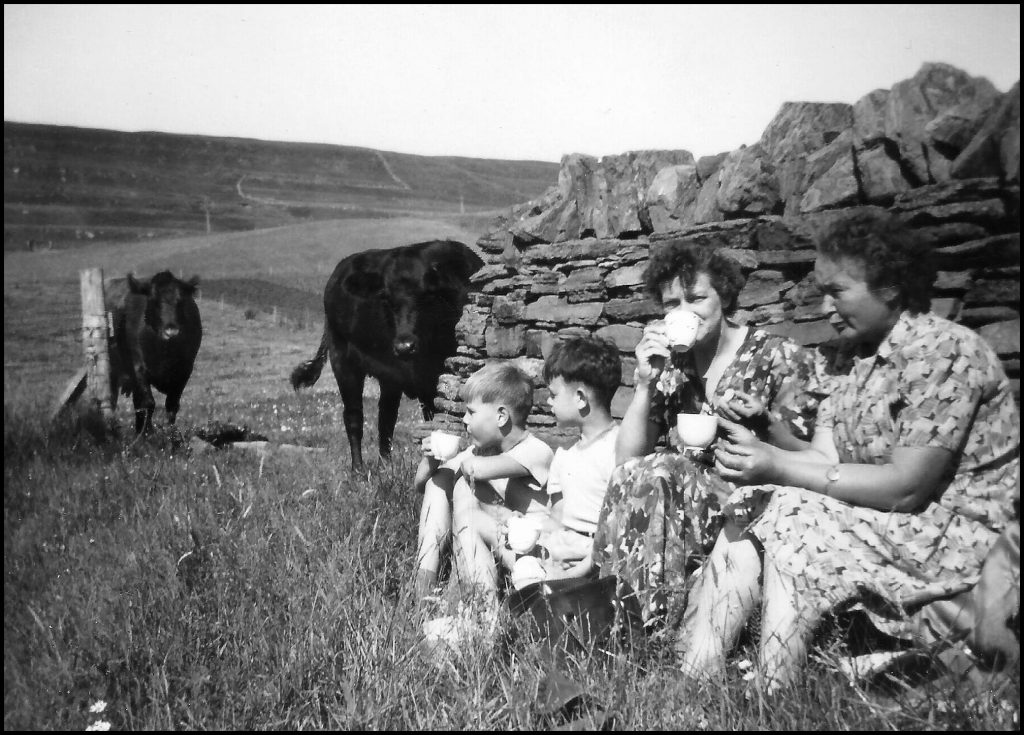
My brother and me with Mum and Auntie Mabe. Must be the very early fifties.”
Outings and the Picnic
We spent much of our summers in Wasbister roaming over the braes and generally enjoying life. We stayed either at Hammerfield or the Schoolhouse (or sometimes both); it all depended on how many kids were about. There were cousins and second cousins to cater for so sometimes we overflowed into Lower Hammerfield. At that time Uncle Bill used it as his brewery so the usual bottles of home-brew could be found stored in the cupboard. For a few nights one summer, Ian, my cousin, and my brother were sleeping there so discovered the ‘hoard’. Temptation was too much so they had to have a few samples. Few turned into several but it didn’t seem to affect them. I was upset because I missed all the fun as I was staying down at the Schoolhouse.
The caithes hanging from the ceiling were, in earlier times, almost a staple of island life. Uncle Bill caught them off the rocks using a wand and line. A wand is a length of sturdy bamboo, probably a dozen or so feet long to which was attached the fishing line and hooks, red and white flies as I recall. Once he took my brother and me down to the shore to fish; he did the fishing and we did the watching. I remember the walk from Hammerfield over Brings to a geo which I think must have been Quoy Geo. Some of the walk was over shingle and on the way we were accosted by many birds. Uncle Bill’s knowledge was revealed – he seemed to know them all; terns, oystercatchers, bonxies, arctic skuas and others. He also had sharp eyes and stopped us treading on their nests more than once. We reached the geo and UB (as Auntie Mabe frequently called him) got things prepared. He got us installed safely and then crossed to the far side of the geo for the fishing. Almost at once he caught a large caithe, much bigger than the ones back at Hammerfield. Soon he caught another but it looked different; it had a sort of golden sheen to it. Later I discovered that this was a lythe, a close relative of the caithe. I cannot remember how long we stayed and how many fish were caught but it was a very exciting outing and a long trek back to Hammerfield for tea.
As is common in this life we had to endure the dreaded visits to relations. Most of these visits have long been forgotten but a couple of must have impressed me. I remember visiting Fa’doon probably because of the story Mum told on the way back to Wasbister. I remember the trip there and the location of the house; you took a hairpin left off the steep hill down into Sourin and the house was just a hundred metres or so from the road. I have no memory of the folk but I was told that they were some relation, probably Grieve. All I remember of the story was that a son of the house wanted to emigrate to Australia but had died tragically on the way through the Mediterranean. This turned out to be partly true and the full tale is told by Robert C. Marwick and is reproduced on Rousay Remembered under the ‘Anthology’ tag. The son’s name was David Craigie and he died in 1884 of sunstroke in the Red Sea. He would have been my Auntie Maggie’s father’s cousin. She was Maggie Jessie Inkster, Hugh Craigie of Deithe’s daughter. The only other memorable visit was to Greenfield in Brinian. I was very young then but I remember that it really was green; hedges and climbing plants and a large garden. There were two old ladies as I remember and one must have been Isabella Inkster, nee Craigie. Her husband was Frederick (Fred) who was my Grandma’s oldest brother but he had died in 1944. The other lady was, I think, Mary, her sister. We were invited in and I was amazed; the parlour seemed to be packed with polished brass shell cartridges of many sizes. They were on the mantelpiece, bookcase and sideboard. That kept me quiet for a long time.
A highlight of the holidays was the picnic and we visited many places; the Muckle Watter, Mid Howe, Scockness and Quandale among others whose names I probably never knew. Picnics at Quandale down on the rocky shore were probably my favourite. We would all descend on Hammerfield and the lucky ones got a ride in the back of Uncle Dave Miller’s short wheelbase Landrover to the shore. On the way we watched the bonxies harrying the other birds, very acrobatic. When we got to the rocks we scoured the place for driftwood so we could get a fire going and the kettle on. We youngsters got on the dookers for a splash about in the pools and even the sea. I couldn’t swim then but that didn’t matter. UB was a dab hand at building so he would build a cairn or two. I had a little 127 Kodak at the time so I took a few shots. I’m afraid that the negatives were mislaid so these pictures were scanned from the original contact prints.
Some of our Escapades
The nearest neighbour to Hammerfield was Tou. Roderick and Evelyn Marwick and their family lived there but soon moved to Cogar, opposite the Schoolhouse. We had a great time playing with their offspring; Sheena, Jimmy, and Alastair around the Schoolhouse and loch; rowing about using a borrowed rowing boat with our second cousins Ruthie, William and Judy Miller; their mum was Auntie Lily, the school teacher. On the north-east side of the loch there is a boathouse, with a dam and a weir across the Saviskaill burn maybe adding a metre to the original level of the loch. I was told that a former laird had wanted a trout loch so had ordered the work and had stocked it. I always wondered who this was but I can find no record of when the work was done. Before that, the loch must have been quite shallow and it was rumoured the Burrian had not always been an island. One year one of the boys of Saviskaill had dammed the Saviskaill Burn down at the beach so creating a mini-loch. He had somehow got an oil drum partially split in two so that it formed a hinge along one side. The two halves were opened up like a book and some boards were lashed across to form a seat. It became a small boat. Fantastic fun, but it didn’t last long; the sea can be very mean.
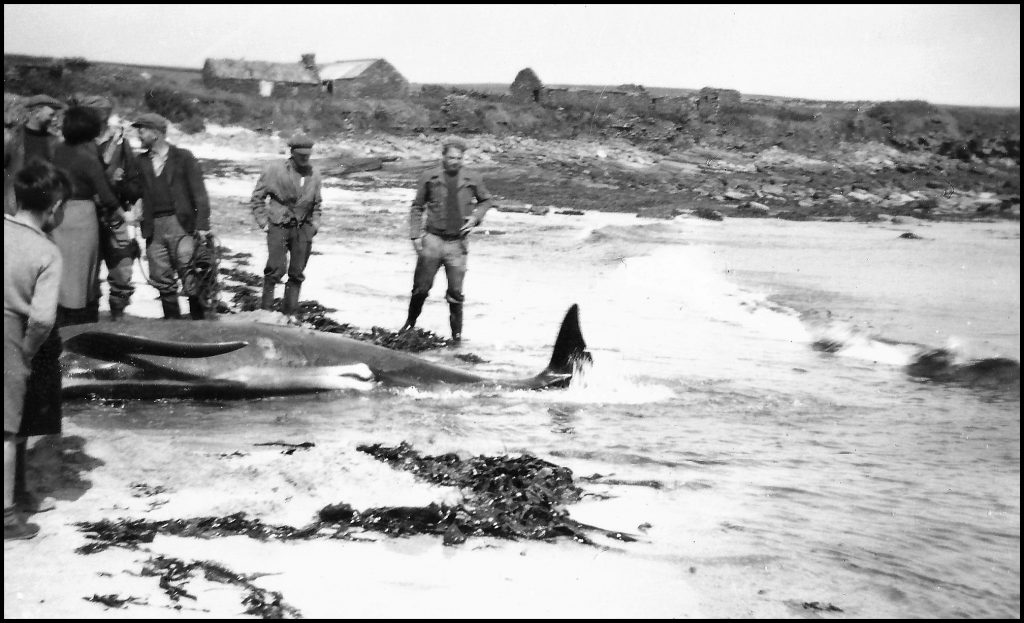
Harold Grieve is the boy on the left; Roderick Marwick with the rope; Bill o’ Furse (Grieve);
the elegant lady in skirt Mrs Dickie; and maybe Hugh o’ Saviskaill.
Another option is the young man on the right is Colin o’ Saviskaill.
One summer there was great excitement in the Schoolhouse; a beached ‘whale’ had been reported on the shore at Saviskaill. We had to go and have a look so we all ran down to the beach. When we got there the creature was still alive and a group of men, including UB and Roderick Marwick, was working trying to get it into the water. The animal was stranded on the sandy part of the shore so the men were trying to dig a trench along its side in an attempt to roll it into the water so it could be pulled into the sea. Despite their efforts this was unsuccessful and I think the ‘whale’ must have got injured during the work; an angry looking gash could be seen on the animal’s side. It looked to be in real distress and was making a good deal of noise through its blowhole. It was a real pity, but nothing could be done to help the poor thing. I seem to recall that it lay overnight and died the following day. I do not know how or if the carcase was removed. At the time I thought that it was a baby sperm whale just because of the shape of its rather bulbous head. I now realise that this was unlikely as it was only about four metres long. More probably it was a type of porpoise.
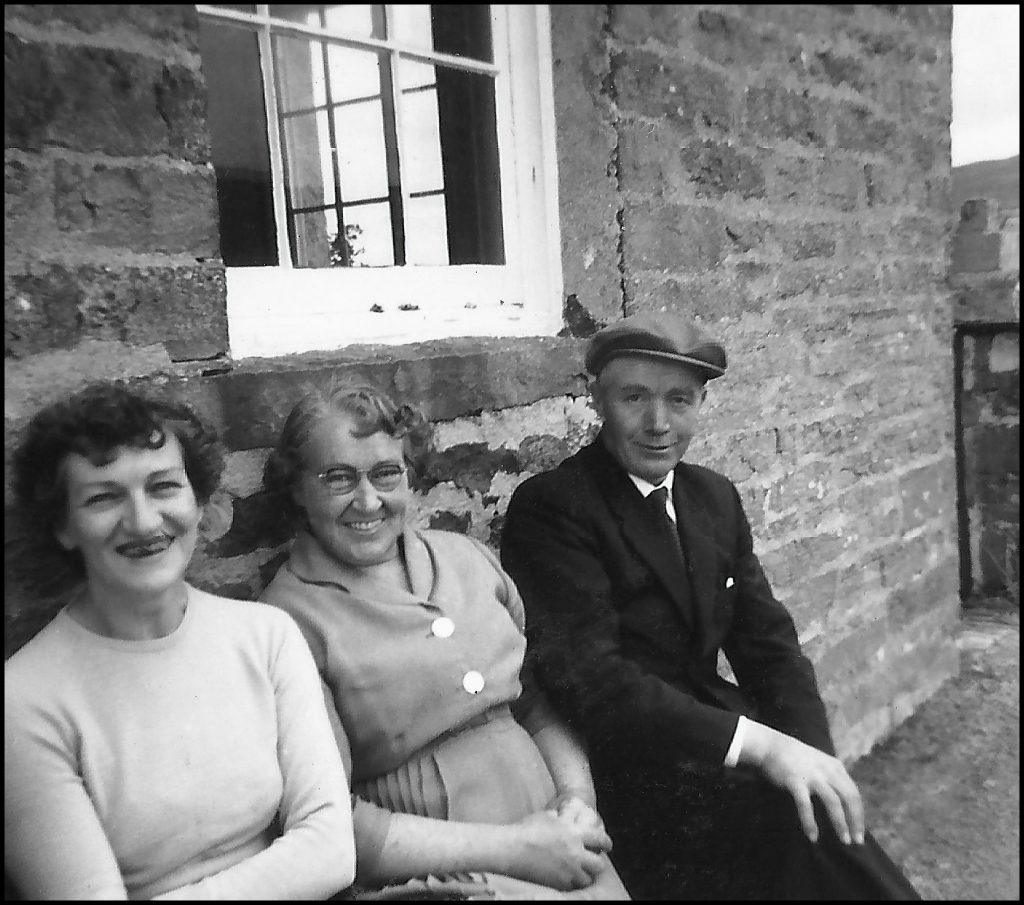
Other entertainments included the Pictures at the hall, maybe once or twice a month. The only film which I remember was called The Prisoner starring Alec Guinness and Jack Hawkins, all dark and moody, and a bit nasty for a ten-year-old. These shows must have been quite a novelty because the hall was invariably full to capacity. Jimmy Shand and his band also paid a visit. I am afraid that I don’t remember the music but the show provided me with my first experience of a magician. I was fascinated, and still am. He was a dab hand at finding coins in all sorts of weird places.
As it is now Rousay was a place where there were few shops. As I recall there was one in Hullion and one next the school down the road from the hall in Sourin. There may have been one at the Pier; we rarely went there unless it was to meet the boat, the Earl Sigurd or Earl Thorfinn. And we didn’t seem to mind; Dave Gibson’s van came along from Hullion once a week so we could spend our pocket money then. All sorts of goodies were available and we were keen to spend the cash burning holes in our pockets. Grown-ups too had the opportunity to have a good natter.
Mum (Rhoda), Auntie Mabe
and UB at the Schoolhouse
The Craigies of Deithe
We were often visited by UB’s nephews, Neil and Francis Craigie of Deithe. Their father was James Craigie and mother was UB’s sister, Maggie Jessie. Neil went on the join the Northern Lighthouse Board as a lighthouse keeper while Francis, my sister tells me, joined the Kirk. Francis was a keen photographer and I was fascinated by his camera and pictures. His camera was a manual 2¼ square format and I seem to remember that it was a single lens reflex (SLR). If that was the case, it must have been a very early one. All his photographs which I saw were taken on Agfachrome slide film which he viewed though a hand held viewer. Agfachrome film was a very distinctive film with its intense reds. I was becoming quite keen on photography but all I could afford at that time was my little 127 format Kodak, complete with single lens, single shutter speed, single aperture and fixed focus! Monochrome films as well; colour was away beyond my means. However, he gave me a few pointers and showed me how to calculate shutter speeds and apertures. He demonstrated his ‘Color Calculator’, a manual device for estimating the light value and hence shutter speeds and apertures. Later I upgraded to a 35mm camera with a few bells and whistles so I went out and bought one. I still have it somewhere in the glory hole. Neil and Francis had a brother, Tommy who was adopted by his father’s sister, Barbara, so had the name Mainland. He was a regular visitor too. I remember him in Fergie’s garage making beautiful little models of WW2 aircraft out of pieces of scrap timber. He would carve out the pieces and fix them together with adhesive and shortened dressmaker’s pins and then paint them. One of these models, a spitfire, had pride of place on the Schoolhouse’s mantelpiece for a while.
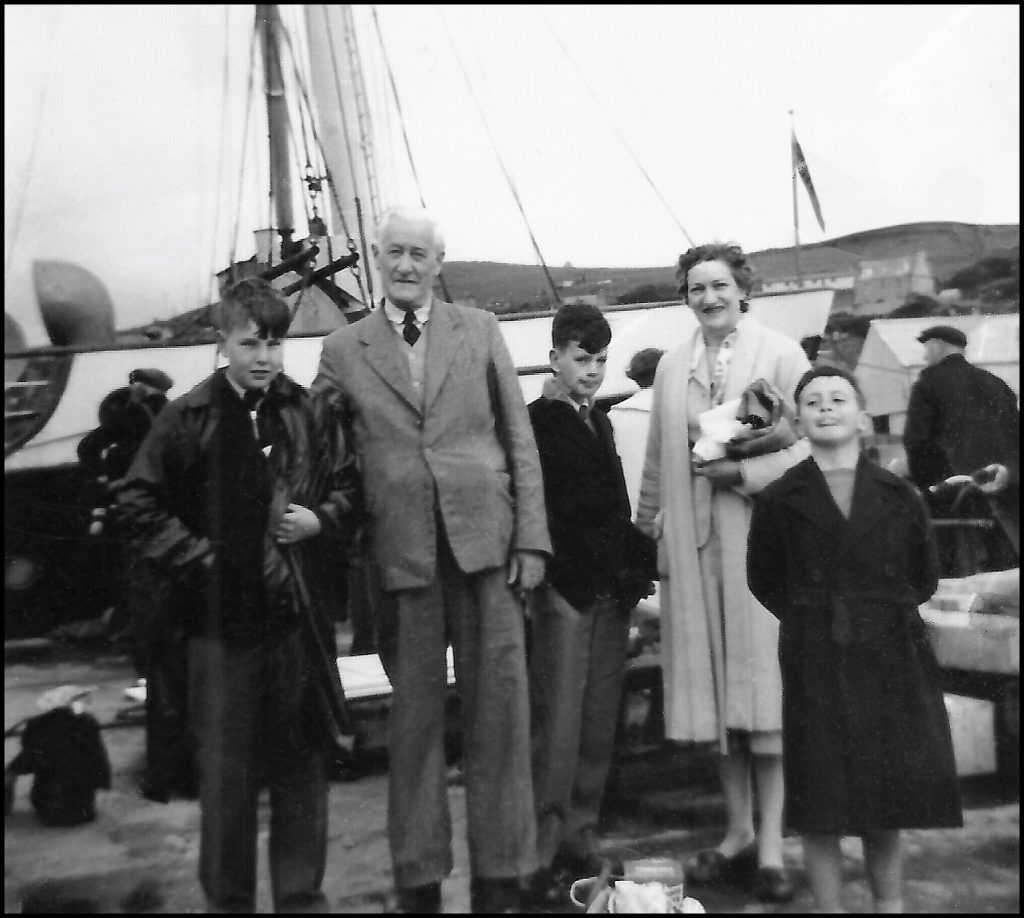
The Wedding
In the summer of 1961 my second cousin Ruthie Miller got married to Jim Gibson of Lopness. The wedding service was held in the Kirk in Sourin and the wedding breakfast at the hall. In Rousay there was a distinct lack of limousines so it was decided that the bridal car would be the old Fordie (maybe because it was handy and black). But it needed some work. I helped to wash and polish it but, what about the rusty bits? UB came to the rescue and got out the boot polish and we blacked-up and polished the rust. It looked quite good – from a distance. It turned out a nice day and all went well. After the service the party moved to the hall where everyone had a great time. I think that Jim o’ Feolquoy and friends may have supplied the music: I remember him from dances at Wasbister School; being a demon accordion player; he really put everything in to it. He was a keen motor cyclist too (biker, they would say nowadays). I think that he had a Norton and it looked to me to be a huge and powerful beast. I had my first ever and last ever ride pillion ride, up the Leeon and back again. There were no safety helmets in those days.
Jimmy, Da, me, Mum, and Graham Rosie
before boarding the St Magnus – leaving
Orkney for a new home in Aberdeen.
Graham is a friend, son of Jean
Rosie, music teacher at KGS.
The Latter Days
In August of 1961 our family moved to Aberdeen so we had no more long holidays in Rousay, just the occasional short stay and day trip. Not long after we moved, the Millers of the Schoolhouse moved to Keig in Aberdeenshire where they took over the shop and Auntie Lily taught at a local school. But UB and Auntie Mabe stayed on at Hammerfield. Nothing much changed, although there was talk about a septic tank and an inside toilet. I got married in 1979 and in the summer of that year took Avril, my wife, to Hammerfield for a short holiday. We had a wander over the braes and down towards Quandale with Spotty, Bill’s faithful dog. He was very happy to come along with us and enjoyed collecting stones for us to throw for him. It was a beautiful day and a lovely walk.
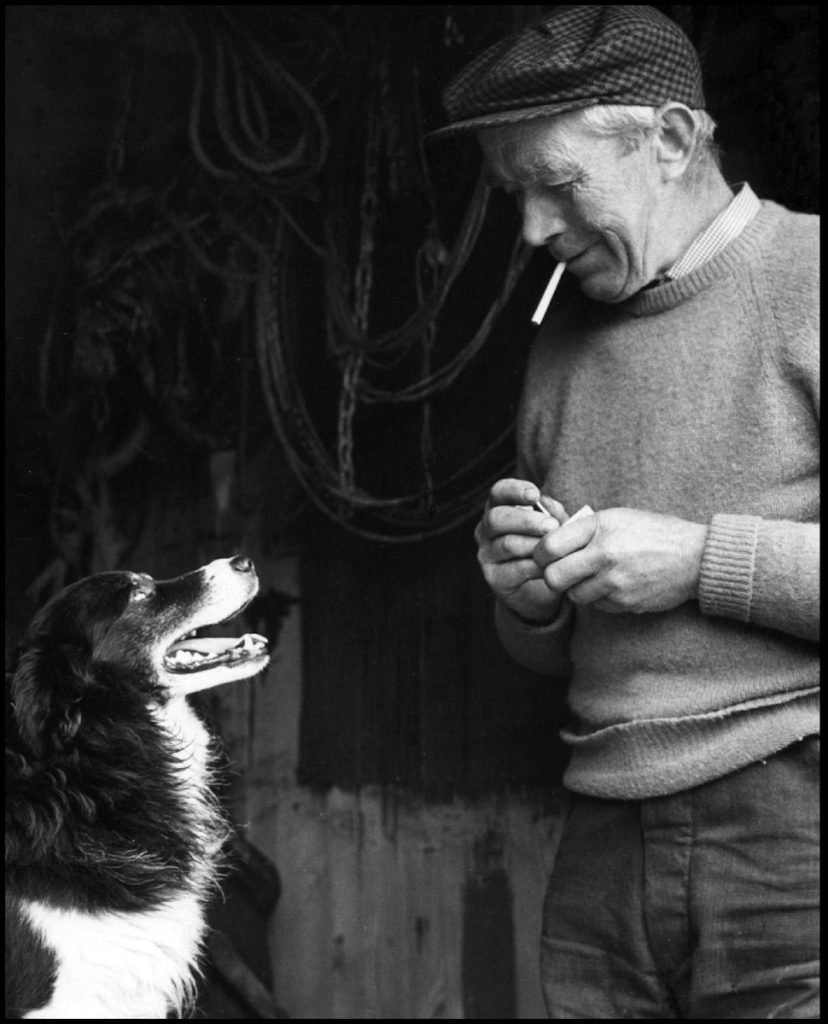
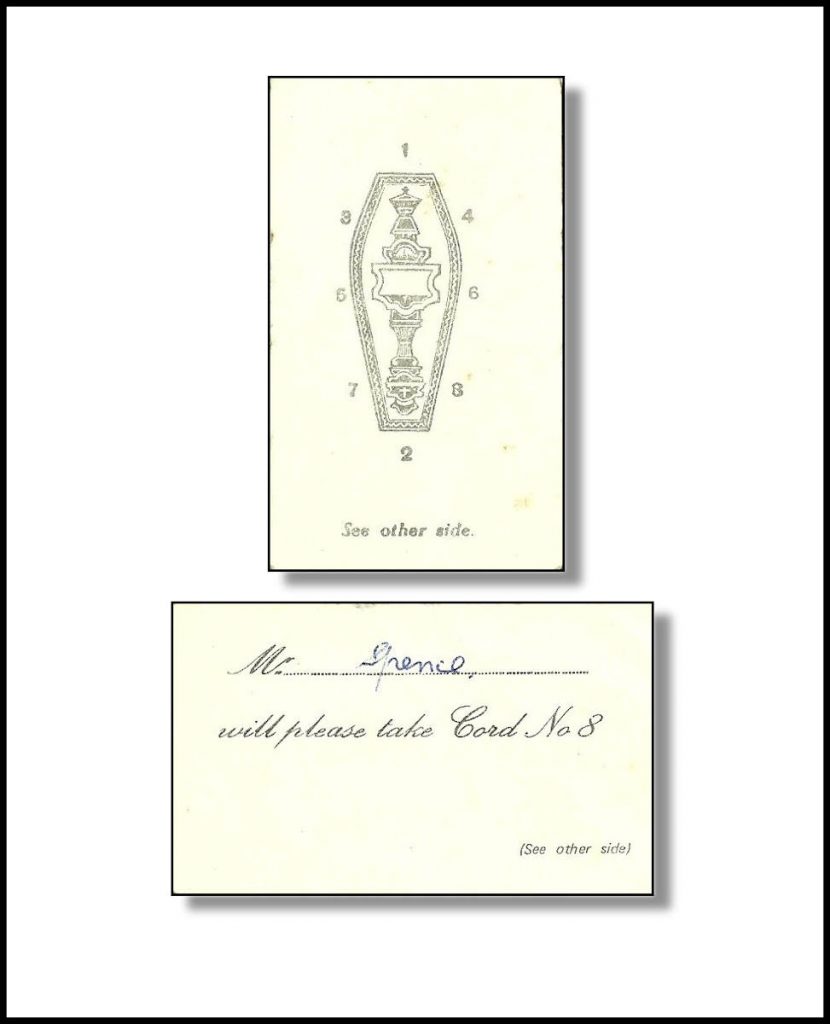
At that time UB was showing signs of dementia and not long after was admitted to hospital in Kirkwall where in 1981 he died. I attended the funeral and was given the honour of being pallbearer no 8. I still have the Pallbearer card. No suitable vehicle was available so the coffin was transported from the ferry to the cemetery in the back of a van. Nowadays this would be seen to be disrespectful; but this definitely was not the case. It was all very sad.
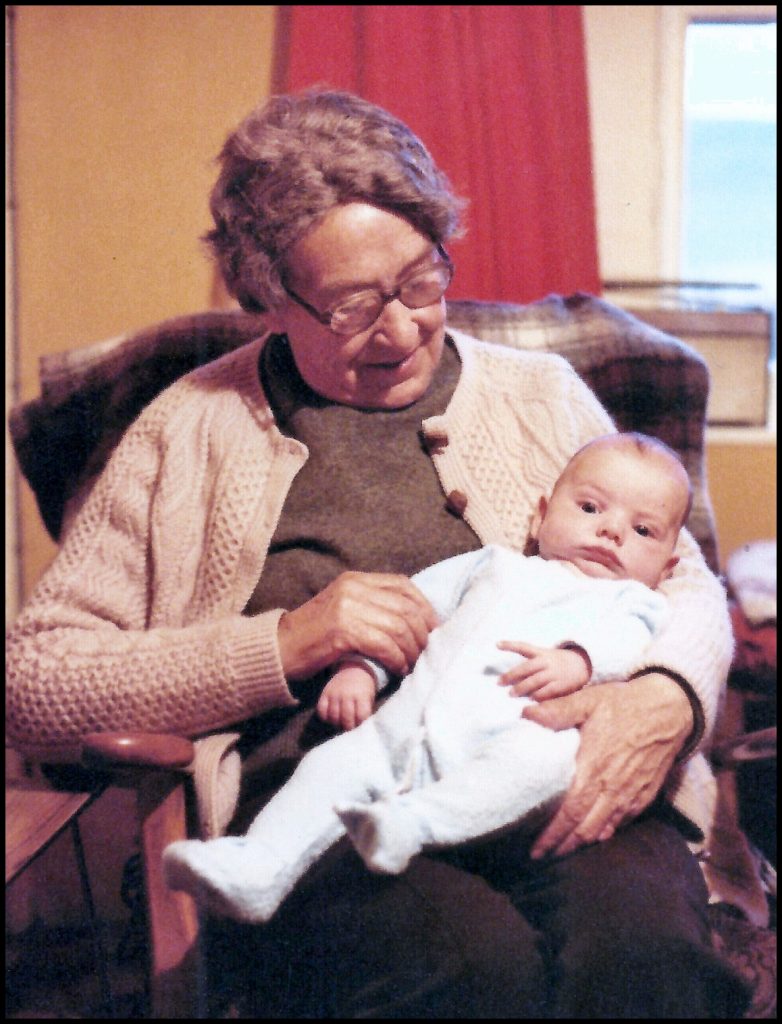
Auntie Mabe stayed on at Hammerfield for a few years and we visited her again in 1982, the summer in which our son was born. In 1983 she moved to sheltered housing at Lambaness in Kirkwall, where we visited (and Mum stayed) several times before her death in 1995. I have visited Rousay for day trips several times since and taken a trip or two up to the farm after visiting Tou. Once I had a look in the garage at the end of the house and I saw a rusting old car. Maybe it was some other vehicle but I like to think it was the old Fordie. Sadly the house is no more but the steading has been converted to a dwelling house.
Auntie Mabe with our baby
son, Martin in 1982
© Rognvald Spence, January 2017
[My grateful thanks to Ron for sharing his fascinating reminiscences,
family photos and their captions]
